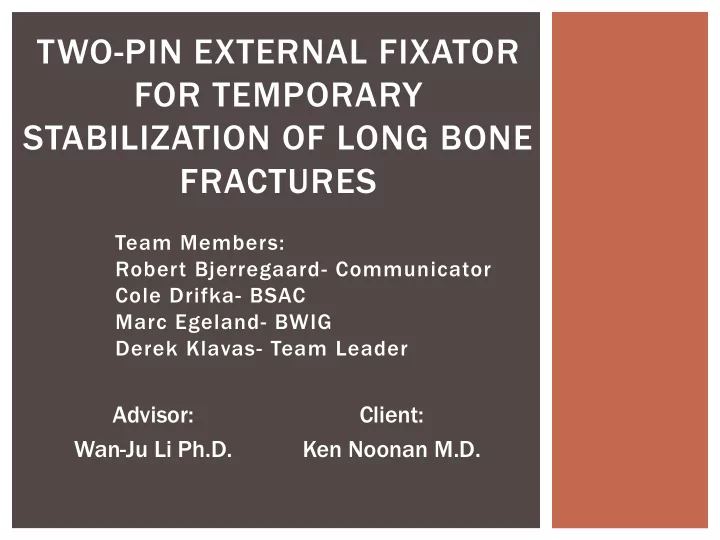

TWO-PIN EXTERNAL FIXATOR FOR TEMPORARY STABILIZATION OF LONG BONE FRACTURES Team Members: Robert Bjerregaard- Communicator Cole Drifka- BSAC Marc Egeland- BWIG Derek Klavas- Team Leader Advisor: Client: Wan-Ju Li Ph.D. Ken Noonan M.D.
OVERVIEW Background Motivation: 4-Pin vs. 2-Pin Existing Devices Client Requirements This Semester’s Work External Fixator Bar Design Options Pin Support Design Options Future Work Acknowledgements
BACKGROUND Multi-injury trauma patients often require temporary fixation of the femur Temporary http://www.1-800-translate.com/TranslationBlog/wp- content/uploads/2010/06/emergencyroom.jpg immobilization of the upper leg for up to 48 hours Patient may undergo bed-to-bed transfer, femur should remain stabilized throughout
MOTIVATION 4-Pin External 2-Pin External Fixation Fixation 4 terminally threaded 2 terminally threaded pins pins 2 proximal and 2 distal to 1 proximal and 1 distal to fracture site fracture site Procedure must be Procedure can be conducted in the conducted immediately Operating Room in the Emergency Room Alignment of 4 pins is Minimal time, only one time consuming, physician necessary requiring multiple physicians
EXISTING DEVICES Monutube Triax External Traction pin stabilization Fixus 99 External Fixation System Fixation System http://www.osteosynthesis.stryker.com/me http://emedicine.medscape.com/article/1 http://www.fixus.nl/fixus99.html dias/pdf/triax_optech_50752504a2806.p 270717-treatment df • There are currently no known two-pin fixation devices on the market
CLIENT REQUIREMENTS Implemented in ER by a single resident or staff physician Installation time must be at most twenty minutes A maximum of two fixation pins must be used Device must fit wide range of patients External bar must be radiolucent, and entire device must be MRI compatible
CLIENT REQUIREMENTS Implemented in ER by a single resident or staff physician Installation time must be at most twenty minutes A maximum of two fixation pins must be used Device must fit wide range of patients External bar must be radiolucent, and entire device must be MRI compatible Future Work
THIS SEMESTER’S WORK Design a pin with increased rotational stability Construct a temporary external fixator that is easy to apply http://www.engr.wisc.edu/alumni/perspective/34.3/gi ft03PeterTong.html
STANDARD FIXED BAR External bar with no joints Pros: Easy to construct the bar Streamlined design after installed Cons: Requires complicated clamp design Fits a limited range of pin locations
SINGLE AXIS ROTATION Joint allows for rotation along long axis of bar Pros: Fits a wider range of pin orientations Extra degree of freedom Less complicated clamp design – easier installation Cons: More complicated design
BALL-AND-SOCKET Dual ball-and-socket allows for Pros: Fits the widest range of pin locations Three degrees of freedom Least complicated clamp design – easy installation Cons: Bulky and complex design
Fixation Bar Design Matrix Design gn Charact acter eristi stics cs Fix ixed Bar Sin ingl gle e Axis is Ball ll-and nd-Soc Socket Rota otation tion Ease of Installation (40) 20 35 40 Cost (10) 10 6 8 Ergonomics (20) 20 17 15 Manufacturability (10) 8 6 10 Adjustability (20) 10 18 20 Total (100) 68 82 93
MOLLY BOLT Drill hole, slide in pin, screw to expand Pros: Greater stability than standard pin Cons: Potential damage to bone Could be difficult to remove Targets soft trabecular bone
EXPANSION PIN Insert pin, screw in central bore 4 expandable segments grip cortical bone to increase stability Pros: Greater stability than standard pin 30% higher pullout strength than standard pin [2] Cons: Potential damage to bone and surrounding tissue More difficult to manufacture
NEGATIVE FEEDBACK PIN Reverse threading combined with external sleeve Loosening of inside pin causes external sleeve to drive deeper into cortical bone Pros: Exceptional stability Cons: Bulky Hard to manufacture
Support Pin Design Matrix Design gn Charact haracter eristi stics cs Moll lly Bolt lt Expansio nsion n Pin in Negati tive e fe feedbac back k Pin in Rotational Stability 28 35 30 PIN DESIGN MATRIX (40) Ease of Installation 12 12 10 (15) Manufacturability (10) 5 9 7 Potential Damage to 10 15 18 Tissue (25) Cost (10) 7 7 7 Total (100) 62 78 72
FINAL DESIGN
FUTURE WORK Test stability of existing expansion pin in animal bone Construct pins and fixation bar Test stability of entire fixator Design entire fixator to be MRI compatible Design fixation bar to be radiolucent
ACKNOWLEDGEMENTS Dr. Wan-Ju Li Dr. Ken Noonan
REFERENCES http://www.3dcontentcentral.com/Search.aspx?arg=femur Cook et. a l. “Lumbosacral fixation using expandable pedicle screws: an alternative in reoperation and osteoporosis” . The Spine Journal. Vol. 1, Issue 2. 2001.
QUESTIONS?
Recommend
More recommend